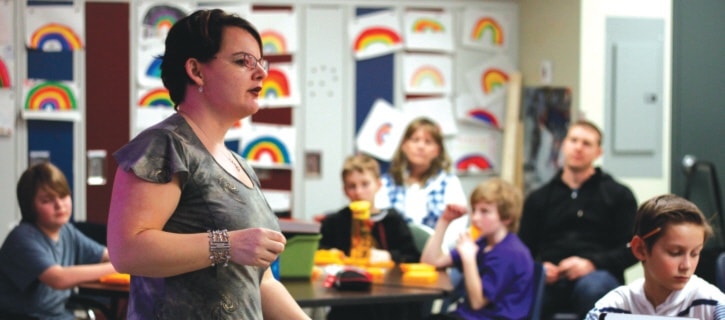Math expert Sandi Berg demonstrated modern teaching strategies to math teachers at École Mother Teresa School Jan. 23. She did so by using fraction blocks and algebraic tiles to show teachers how they can help students solidify math concepts using visual tangible tools, then write it out in abstract math equations.
Berg said the process helps enhance a student’s understanding of an abstract math equation, as they can visually see a math equation when they work with tangible blocks and tiles.
Berg is an elementary-trained high school math teacher and is the school’s resident math expert for the school year. She is a curriculum implementation support consultant from Central Alberta Regional Consortium (CARC), and travels to eight school districts within Alberta.
During her classroom visits, Berg aims to show teachers different teaching strategies they can implement into their teaching style to help students understand math equations.
Some of the new teaching styles include getting students to work with physical manipulatives, which Berg described as anything they can move with their fingers, such as fraction blocks and algebra tiles. By working with blocks and tiles, students can visualize the mathematical expressions, and Berg said this is how students learn what is going on.
“Most kids are successful when they can see what’s going on and they understand what’s happening,” Berg said. “When you teach them in a tangible way and they are manipulating the box and building the numbers, they can see what’s happening.”
Berg said her goal is to help students build a concrete understanding of what they are doing by teaching them the tangible manipulative concept first, then allowing them to connect the visual concept with the abstract numeric concept math equation.
“As students are ready they move away from the concrete and they do just the abstract,” Berg said. “So my goal is to get them to the abstract, but they can use the manipulatives as long as they need it.”
Berg has been working in her position for four years now and said that the provincial government understands that teachers need support, especially when educational philosophies change. She said teachers need to learn how to help students understand what they are learning.
“If (teachers) weren’t doing it before, they aren't just going to magically start doing things in the new philosophy,” Berg said.
For some teachers, the thought of using tangible manipulatives to teach and reinforce abstract math concepts to their students can be daunting, as some teachers have always taught just the abstract math.
Berg said that a lot of teachers understand they can make learning math easier through the use of tangible tools, but some teachers just don’t know how to teach in that way.
“A lot of manipulatives are fairly new for some teachers, but other teachers have been using them for years.” Berg said. “Some teachers will invite me (into their classrooms) and even though they are quite confident in doing it (themselves), they are just looking for new ideas.”
Berg said that even as blocks have been around for many years, their effectiveness depends on whether a teacher has ever learned how to use them in the classroom. She said every teacher’s teaching style is different and personalized, with some teaching styles matching up well to how their students learn. But still some teachers want to learn different ways on how to teach.
“It’s like anything, you never know something until someone shows you that it’s a possibility,” Berg said. “My goal is to try to show them something new because if I’m just going in and showing them what they are already doing, it was a wasted visit.”
During her model lessons, Berg shows teachers other strategies such as teaming students up into groups of two and allowing those students to work together and explain to each other their mathematical reasoning and answers.
“A lot of students don’t know how to explain how they got an answer, so I try to encourage them as much as possible to explain their reasoning behind it.” Berg said.
Berg gave an example of how she taught her niece in Grade 3 to solve simple algebraic expressions on her own with the use of household items. She said her niece had a total understanding of what was going on simply because she was learning in a visual way.
“Give the same algebraic expression or equation to an adult and they will look at you with a blank look on their face,” Berg said. “Most adults hate math. They couldn’t learn it the way it was taught to them and they weren’t taught how to visualize, they were just told ‘do this’ and that’s just because it was the rule.”
Berg said that she has used the tangible manipulatives to teach math in her own classroom and said she has seen her students’ grades go up because her students have understood the concepts more deeply.
“We wonder why kids are mixing up the fraction rules. There are just so many rules to memorize, but when you use the manipulative, they can see why when you’re adding fractions, you’re not adding the denominators. It’s obvious, it’s clear to them.
“We’ve actually seen where a Grade 3 class who has worked with fraction blocks and a Grade 9 class who has only ever worked with abstracts. A Grade 3 student can reason more complicated math for fractions than a Grade 9 student because the Grade 9 student just can’t picture it,” Berg said.
Even as Berg promotes the idea of teaching students the tangible way of learning the manipulatives before the abstract, she has no problem with students learning just the abstract traditional way as long as they have a full comprehension of what they are doing.
“If they use manipulatives to do it, great. If they are doing it with another procedure, that’s fine too — as long as they have that understanding that goes behind it.”
